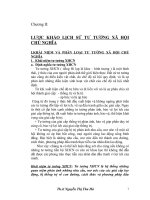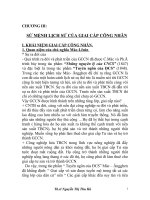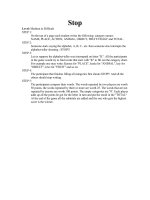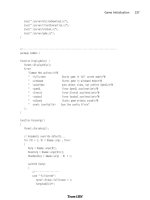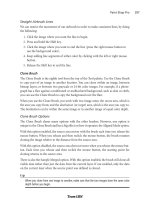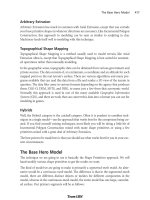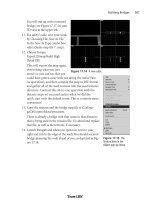One stop doc cardiology
Bạn đang xem bản rút gọn của tài liệu. Xem và tải ngay bản đầy đủ của tài liệu tại đây (1.97 MB, 145 trang )
ONE STOP DOC
Cardiology
One Stop Doc
Titles in the series include:
Cardiovascular System – Jonathan Aron
Editorial Advisor – Jeremy Ward
Cell and Molecular Biology – Desikan Rangarajan and David Shaw
Editorial Advisor – Barbara Moreland
Endocrine and Reproductive Systems – Caroline Jewels and Alexandra Tillett
Editorial Advisor – Stuart Milligan
Gastrointestinal System – Miruna Canagaratnam
Editorial Advisor – Richard Naftalin
Musculoskeletal System – Bassel Zebian, Wayne Lam and Rishi Aggarwal
Editorial Advisor – Alistair Hunter
Nutrition and Metabolism – Miruna Canagaratnam and David Shaw
Editorial Advisors – Barbara Moreland and Richard Naftalin
Respiratory System – Jo Dartnell and Michelle Ramsay
Editorial Advisor – John Rees
Renal and Urinary System and Electrolyte Balance – Panos Stamoulos and Spyridon Bakalis
Editorial Advisors – Alistair Hunter and Richard Naftalin
Statistics and Epidemiology – Emily Ferenczi and Nina Muirhead
Editorial Advisor – Lucy Carpenter
Immunology – Stephen Boag and Amy Sadler
Editorial Advisor – John Stewart
Gastroenterology and Renal Medicine – Reena Popat and Danielle Adebayo
Contributing Author – Thomas Chapman
Editorial Advisor – Stephen Pereira
Volume Editor – Basant Puri
ONE STOP DOC
Cardiology
Rishi Aggarwal MBBS
Graduate of Guy’s, King’s and St Thomas’ Medical School and Senior House Officer in Accident and
Emergency Medicine, Wexham Park Hospital, Slough, UK
Emily Ferenczi BA (Cantab) BMBCh (Oxon)
FY1 Hammersmith Hospital Academic Foundation Programme, London, UK
Nina Muirhead BA (Oxon) BMBCh (Oxon)
FY1 Royal Berkshire Hospital, Reading, UK
Darrel Francis MA (Cantab) MB BChir MD MRCP
Clinical Academic in Cardiology, International Centre for Circulatory Health, Imperial College of
Science and Medicine, London and Honorary Consultant Cardiologist, St Mary’s Hospital, London, UK
Volume Editor: Basant K Puri MA (Cantab) PhD MB BChir BSc (Hons) MathSci MRCPsych DipStat MMath
Professor and Consultant in Imaging and Psychiatry and Head of the Lipid Neuroscience Group,
Hammersmith Hospital, London, UK
Series Editor: Elliott Smock MBBS BSc (Hons)
FY2, University Hospital Lewisham, Lewisham, UK
A MEMBER OF THE HODDER HEADLINE GROUP
First published in Great Britain in 2007 by
Hodder Arnold, an imprint of Hodder Education and a member of the Hodder Headline Group, an Hachette
Livre UK Company, 338 Euston Road, London NW1 3BH
© 2007 Edward Arnold (Publishers) Ltd
All rights reserved. Apart from any use permitted under UK copyright law,
this publication may only be reproduced, stored or transmitted, in any form,
or by any means with prior permission in writing of the publishers or in the
case of reprographic production in accordance with the terms of licences
issued by the Copyright Licensing Agency. In the United Kingdom such
licences are issued by the Copyright Licensing Agency: Saffron House,
6–10 Kirby Street, London EC1N 8TS.
Whilst the advice and information in this book are believed to be true and
accurate at the date of going to press, neither the authors nor the publisher
can accept any legal responsibility or liability for any errors or omissions
that may be made. In particular, (but without limiting the generality of the
preceding disclaimer) every effort has been made to check drug dosages;
however it is still possible that errors have been missed. Furthermore,
dosage schedules are constantly being revised and new side-effects
recognized. For these reasons the reader is strongly urged to consult the
drug companies’ printed instructions before administering any of the drugs
recommended in this book.
British Library Cataloguing in Publication Data
A catalogue record for this book is available from the British Library
Library of Congress Cataloging-in-Publication Data
A catalog record for this book is available from the Library of Congress
ISBN 978 0340 925577
1 2 3 4 5 6 7 8 9 10
Commissioning Editor: Sara Purdy
Project Editor:
Jane Tod
Production Controller: Lindsay Smith
Cover Design:
Amina Dudhia
Indexer:
Indexing Specialists (UK) Ltd
Typeset in 10/12pt Adobe Garamond/Akzidenz GroteskBE by Servis Filmsetting Ltd, Manchester
Printed and bound in Spain
What do you think about this book? Or any other Hodder Arnold title?
Please visit our website at www.hoddereducation.com
CONTENTS
PREFACE
vi
ABBREVIATIONS
vii
SECTION 1
HISTORY AND EXAMINATION
SECTION 2
SYMPTOMS
11
SECTION 3
INVESTIGATIONS
21
SECTION 4
THE ELECTROCARDIOGRAM
33
SECTION 5
CONDITIONS
71
SECTION 6
TREATMENTS
117
1
APPENDIX
127
INDEX
129
PREFACE
From the Series Editor, Elliott Smock
Are you ready to face your looming exams? If you have
done loads of work, then congratulations; we hope
this opportunity to practice SAQs, EMQs, MCQs
and Problem-based Questions on every part of the
core curriculum will help you consolidate what you’ve
learnt and improve your exam technique. If you don’t
feel ready, don’t panic – the One Stop Doc series has
all the answers you need to catch up and pass.
There are only a limited number of questions an
examiner can throw at a beleaguered student and this
text can turn that to your advantage. By getting
straight into the heart of the core questions that come
up year after year and by giving you the model
answers you need this book will arm you with the
knowledge to succeed in your exams. Broken down
into logical sections, you can learn all the important
facts you need to pass without having to wade
through tons of different textbooks when you simply
don’t have the time. All questions presented here are
‘core’; those of the highest importance have been
highlighted to allow even sharper focus if time for
revision is running out. In addition, to allow you to
organize your revision efficiently, questions have been
grouped by topic, with answers supported by detailed
integrated explanations.
On behalf of all the One Stop Doc authors I wish
you the very best of luck in your exams and hope
these books serve you well!
From the Authors, Rishi Aggarwal, Emily Ferenczi
and Nina Muirhead
The horizons of cardiology are expanding at an astonishing rate with the use of medicines such as statins,
thrombolytics and antiplatelet antibodies; interventions such as percutaneous angioplasty and surgery to
implant artificial hearts, to name but a few recent
developments. Patients with congenital cardiac
defects are now living well into adulthood, creating a
new subspecialty of ‘adult congenital cardiac disease’.
For those interested in public health, an increase in
understanding of the importance of primary prevention and early modification of cardiac risk factors has
led to a plethora of new guidelines and targets for
cardiac care in the community.
The WHO has said that by 2020, the leading cause
of global disease burden will be ischaemic heart
disease. As a result, every doctor must expect to face
patients with cardiological problems, no matter what
specialty they eventually decide to pursue. For this
reason it is essential to have a thorough understanding of the basic principles of cardiac physiology,
many of which are based on simple laws of physics –
pressures, resistances and volumes or electrical currents, voltages and conductance. In this book we aim
to inform and to inspire medical students by providing a simple but comprehensive summary of clinical
cardiology with questions and explanations side by
side to make learning relevant to the clinical practice
that they will be witnessing on a daily basis.
We would like to thank Dr Darrel Francis, Professor
Basant Puri, our friends and families, and Hodder
Arnold, for making this book possible.
ABBREVIATIONS
2D
ABC
ACE
ACS
ADH
AF
AIDS
AR
ASD
ASO
AV
AVNRT
AVRT
b.d.
BM
BMI
BP
bpm
CABG
CCU
CK
CK-MB
CNS
COPD
CPAP
CPR
CRP
CT
CXR
DC
DVLA
DVT
ECG
ESR
ETT
FBC
GP
Two-dimensional
Airway, breathing, circulation
Angiotensin-converting enzyme
Acute coronary syndrome
Anti-diuretic hormone
Atrial fibrillation
Acquired immune deficiency
syndrome
Aortic regurgitation
Atrial septal defect
Antistreptolysin-O
Atrioventricular
Atrioventricular node re-entry
tachycardia
Atrioventricular re-entry tachycardia
Twice daily
Boehringer Mannheim (test)
Body mass index
Blood pressure
Beats per minute
Coronary artery bypass graft
Coronary care unit
Creatine kinase
Creatinine kinase, myocardial
isoenzyme
Central nervous system
Chronic obstructive pulmonary
disease
Continuous positive airway pressure
Cardiopulmonary resuscitation
C-reactive protein
Computed tomography
Chest radiography
Direct current
Driver and Vehicle Licensing Agency
Deep vein thrombosis
Electrocardiography
Erythrocyte sedimentation rate
Exercise treadmill test
Full blood count
General practitioner
GTN
HDL
HIV
HOCM
ICS
ICU
IHD
INR
ISMN
IV
JVP
LA
LAD
LBBB
LCA
LCx
LDH
LDL
LMWH
LV
LVH
MI
MR
MRI
NSAID
NSTEMI
PCI
PE
PET
POBA
PTCA
RA
RBBB
RCA
RV
RVH
S1
S2
S3
Glyceryl trinitrate
High-density lipoprotein
Human immunodeficiency virus
Hypertrophic obstructive
cardiomyopathy
Intercostal space
Intensive care unit
Ischaemic heart disease
International Normalized Ratio
Isosorbide mononitrate
Intravenous
Jugular venous pressure
Left atrium
Left anterior descending
Left bundle branch block
Left coronary artery
Left circumflex
Lactate dehydrogenase
Low-density lipoprotein
Low molecular weight heparin
Left ventricle
Left ventricular hypertrophy
Myocardial infarction
Mitral regurgitation
Magnetic resonance imaging
Non-steroidal anti-inflammatory drug
Non-ST elevation myocardial infarction
Percutaneous coronary intervention
Pulmonary embolism
Positron emission tomography
‘Plain old balloon angioplasty’
Percutaneous transluminal coronary
angioplasty
Right atrium
Right bundle branch block
Right coronary artery
Right ventricle
Right ventricular hypertrophy
First heart sound
Second heart sound
Third heart sound
viii
S4
SA
SK
SLE
SSRI
STEMI
SVT
ABBREVIATIONS
Fourth heart sound
Sinoatrial
Streptrokinase
Systemic lupus erythematosus
Selective serotonin re-uptake
inhibitor
ST elevation myocardial infarction
Supraventricular tachycardia
TB
TOE
tPA
U&Es
VF
VSD
VT
ZN
Tuberculosis
Transoesophageal echocardiography
Tissue plasminogen activator
Urea and electrolytes
Ventricular fibrillation
Ventricular septal defect
Ventricular tachycardia
Ziehl–Neelsen
SECTION
1
HISTORY AND
EXAMINATION
• CARDIOVASCULAR HISTORY
2
• SIGNS ON EXAMINATION (I)
4
• SIGNS ON EXAMINATION (II)
6
• MURMURS AND THE CARDIAC CYCLE
8
• LEFT-SIDED HEART MURMURS
10
SECTION
1
HISTORY AND
EXAMINATION
1. Separate the following symptoms/signs into those associated with (i) right-sided heart
failure and (ii) left-sided heart failure (options may be used more than once)
a.
b.
c.
d.
e.
Orthopnoea
Ascites
Paroxysmal nocturnal dyspnoea
Peripheral oedema
Exertional dyspnoea
2. Case study
While working in an A&E department, your registrar asks you to clerk a 57-year-old man who
has been referred by a local GP. Reading the referral letter, you note that the patient has been
complaining of recent onset central chest pain.
a. Using the information given, calculate this man’s body mass index. What does this value
mean?
b. What are the key points to elicit from this man’s history to establish his risk of coronary
artery disease?
The patient goes on to describe a smoking history of approximately 25 cigarettes per day over
a period of 40 years.
c. Convert his cigarette consumption into pack-years
History and examination
3
EXPLANATION: CARDIOVASCULAR HISTORY
History of presenting complaint
• Chest pain (site, character, radiation, precipitating factors, duration and relieving factors)
• Syncope
• Palpitations (duration, frequency of episodes).
Symptoms suggestive of right-sided failure
Symptoms suggestive of left-sided heart failure
Exertional dyspnoea
Exertional dyspnoea (acute/chronic), exacerbating factors (e.g. lying
down), exercise tolerance, association with cough, productive of
sputum – colour/wheeze/haemoptysis
Abdominal swelling suggestive of ascites
Paroxysmal nocturnal dyspnoea (acute shortness of breath that wakes
patient and is relieved by sitting up)
Ankle swelling suggestive of peripheral oedema
Orthopnoea (inability to lie flat – how many pillows required to sleep?)
Past medical history
• Cardiac ischaemia (angina/previous MI)
• Stroke, peripheral vascular disease
• Rheumatic fever
• Hypertension
• Previous cardiac investigations
• Previous treatment: medication/CABG/angioplasty.
Coronary artery disease risk factors (2b)
•
•
•
•
Family history of MI before the age of 55 years in a first-degree relative
Smoker (1 pack-year ϭ smoking 20 cigarettes per day for 1 year)
Hypertension, diabetes mellitus, hypercholesterolaemia
Obesity: BMI ϭ body mass in kilograms/(height in meters)2 (underweight Յ18.5; normal weight
18.5–24.9; overweight 25–29.9; obesity Ն30); it is also important to take fat distribution into account –
abdominal or truncal obesity is associated with hyperinsulinaemia, hypertriglyceridaemia, reduced concentrations of HDL cholesterol and hypertension)
• Gender (males are at greater risk of coronary heart disease)
• Ethnicity (increased coronary heart disease risk in those from the Asian subcontinent).
Social history
• Alcohol intake in units (recommended consumption 21 units per week for men and 14 units per week for
women).
Medications/allergies
• Previous treatment with streptokinase (thrombolytic agent) for MI. See also the explanation on treatments
(see page 77).
Answers
1. (i) b, d, e; (ii) a, c, e
2. a – 30.1, indicating that he is obese, b – See explanation, c – 50 pack-years
ONE STOP DOC
4
3. (a) What is the name given to the clinical sign that is depicted in this series of
diagrams? (b) State two cardiac-related conditions that may cause it
Normal
Early
160°
Late
Gross
Angle obliterated
Straightened
180°
180°<
Swollen terminal
phalanx
4. The drawing on the left shows a thumb from a patient with chronic iron deficiency.
(a) What clinical sign does this patient have? (b) Name another cardiac-related
condition that you may expect this sign to present in. (c) Name the clinical signs
labelled A and B
A
B
5. Hypertensive retinal changes are graded to signify the level of retinopathy. Match each of
the changes below with the appropriate grade of disease in which it would FIRST be seen
Options
A.
B.
C.
D.
E.
1.
2.
3.
4.
5.
6.
Grade 1
Grade 2
Grade 3
Grade 4
Grade 5
Cotton wool spots
Irregular points of focal constriction
Flame haemorrhages
Hard exudates
Minimal arteriolar narrowing
Papilloedema
6. The dusky blue discoloration of a patient’s lips characteristically indicates central
cyanosis. However, what is the minimum level of deoxygenated blood that must be
present for this clinical sign to be apparent? Choose the most appropriate answer
from the options provided
a. 50 g/L
b. 5 mg/dL
c. 0.5 g/dL
d. 5 g/L
e. 5 dL
History and examination
5
EXPLANATION: SIGNS ON EXAMINATION (I)
Hands
• Temperature
• Capillary refill time: apply pressure on nail bed for 5 seconds, after which it should resume normal colour
in Ͻ2 seconds; this is a crude test to establish the degree of peripheral tissue perfusion or dehydration
• Peripheral cyanosis: resulting from peripheral vascular disease or poor cardiac output
• Koilonychia: (spoon-shaped nails) may indicate established iron deficiency or ischaemic heart disease
• Cardiac-related digital clubbing: may be the result of congenital heart disease, bacterial endocarditis or
atrial myxoma
• Splinter haemorrhages: linear haemorrhages in the nail bed, parallel to the length of the nail, that can
present in endocarditis
• Osler’s nodes: painful, pink, pea-sized papules over the finger pads; assoPulse annotation
ciated with bacterial endocarditis
• Janeway lesions: non-tender maculae on the palms and soles that are red
+ + Carotid
to bluish-red in colour; also associated with endocarditis
Brachial
• Nicotine staining: characteristically around index and middle fingers and
+
+
+ Radial
+
supported by presence on teeth.
-
-
+ Femoral
-
+
-
Posterior
tibial +
Popliteal
+ Dorsalis pedis
Pulse
• Radial pulse: note rate, rhythm (sinus/irregularly irregular), volume, character (e.g. slow rising/collapsing), radioradial delay, radiofemoral delay
• Bradycardia: Ͻ60 bpm
• Tachycardia: Ͼ100 bpm.
Eyes
• Xanthelasma: cholesterol deposits located around the eyes
• Conjunctival pallor: present when haemoglobin is Ͻ10 g/dL
• Hypertensive retinopathy: vessels at the back of the eye are
particularly sensitive to hypertension; such changes are
Hard
Retina
exudates
graded as follows
Grade 1: minimal arteriolar narrowing
Papilloedema
Grade 2: marked arteriolar narrowing with irregular
points of focal constriction
Macula
Grade 3: grade 2 plus retinal (flame) haemorrhages,
Flame
haemorrhage
cotton wool spots and/or hard exudates
Grade 4: grade 3 plus swelling (papilloedema) of the optic
disc.
Lips and tongue
• Dusky blue discoloration indicates central cyanosis – at least 5 g/dL of deoxygenated haemoglobin in arterial blood.
Answers
3.
4.
5.
6.
a – Digital clubbing, b – Congenital heart disease, bacterial endocarditis or atrial myxoma
a – Koilonychia, b – Ischaemic heart disease, c – A, Nail fold infarction, B, Splinter haemorrhages
1 – C, 2 – B, 3 – C, 4 – C, 5 – A, 6 – D (grade 4 most severe)
a (conventionally given in g/dL)
ONE STOP DOC
6
7. Concerning the JVP, true or false?
a. The jugular venous pressure is measured with the patient in a recumbent position
b. The jugular venous pressure reflects pressure changes in the left atrium
c. The jugular venous pressure is taken to be the vertical distance (in cm) from the sternal
angle to the top of the jugular venous pulsation
d. A jugular venous pressure of 3 cmH20 is considered to be normal
e. The jugular venous pulsation is not normally visible in the neck
8. Describe the clinical characteristics of the carotid pulse that allow it to be
differentiated from the jugular venous pulse
9. Describe the physiological basis for hepatojugular reflux and its relationship with JVP
10. Describe the physiological basis for Kussmaul’s sign and its relationship with JVP
11. Kussmaul’s sign is most likely be seen in which ONE of the following conditions?
a.
b.
c.
d.
e.
Gastric reflux
Cardiac tamponade
Superior vena cava obstruction
Tricuspid regurgitation
Right-sided heart failure
12. True or false? The following conditions are likely to cause elevated JVP
a.
b.
c.
d.
e.
Pregnancy
Pulmonary embolism
Blood transfusion
Retrosternal thyroid goitre
Emphysema
History and examination
7
EXPLANATION: SIGNS ON EXAMINATION II
The JVP should be assessed with the patient lying at an
angle of 45Њ to the horizontal and in good light. View the
right side of the neck for a double-wave pulsation with each
heartbeat. If this is present, you are observing a column of
blood in the internal jugular vein. Its upward and downward movement reflects pressure change in the right atrium.
Normally, this is less than 3 cmH20 and is not visible, as it
lies just beneath the right clavicle. The value is measured by
taking the vertical distance from the sternal angle to the top
of the jugular venous pulsation. A pressure exceeding
9 cmH20 at the RA (i.e. Ͼ3–4 cm above the sternal angle)
is considered to be raised and consequently abnormal.
Height of
pulsation
Height of pulsation
c
a
x
v
y
S1 Time S2
Sternal angle
Raised JVP
9 cm H2O
5 cm H2O
JVP
RA
0 cm H2O
45°
Components of a normal jugular venous pulse
It is essential that you learn and understand how to differ- a wave
RA contraction
entiate jugular pulsation from the carotid pulse (8), as they c wave
RV contracts causing closure and
both present in the neck. Most importantly, the jugular pulthen bulging of tricuspid valve
Atrial relaxation
sation is non-palpable, rises when pressure is applied to the x descent
v
wave
Ventricular contraction: filling of RA
liver (as this causes more blood to be expelled into the right
y descent
Ventricular relaxation: drop in RA
side of the heart – hepatojugular reflux) and falls when the
pressure as tricuspid valve reopens
patient is upright. The JVP can be stopped by gently pressing against the neck to occlude the internal jugular vein. The carotid pulse is a single pulsation per cardiac cycle
that does not vary with hepatojugular reflux, posture or respiration. It is palpable, but not readily occludable.
Hepatojugular reflux (9) is a useful test in patients with right-sided heart failure, as hepatomegaly may occur
in right-sided heart failure and venous congestion. The patient lies down in the same position as for JVP measurement, keeping the mouth open and breathing normally (to prevent the Valsalva manoeuvre, which may
give a false-positive test). Moderate pressure is applied over the middle of the abdomen for 30–60 seconds. The
test is positive if the JVP increases by at least 3 cm and is maintained during the period of compression.
The physiological norm is for the JVP to rise during expiration and fall on inspiration (along with intrathoracic pressure). Kussmaul’s sign is the paradoxical finding of a rising JVP on inspiration (10); the classical differential diagnosis is constrictive pericarditis, cardiac tamponade or pericardial effusion.
Tricuspid stenosis
Atrial myxoma (commonest primary cardiac tumour)
Retrosternal thyroid goitre
Bronchogenic carcinoma
Increased RV
filling pressure
Obstructed flow
from the RA to RV
Superior vena
cava obstruction
Causes of
elevated
JVP
Positive
intrathoracic
pressure
RV failure (commonly due to LV failure)
Pulmonary embolism (highly unlikely if D-dimer low/normal)
High output states
Increased blood volume (e.g. IV fluids, blood transfusion and acute nephritis)
Restricted RV filling (e.g. constrictive pericarditis and cardiac tamponade)
Pneumothorax
Pleural effusion
Emphysema
Answers
7. F F T T T
8. See explanation
9. See explanation
10. See explanation
11. b
12. T T T T T
ONE STOP DOC
8
13. Match each of the cases described with the most appropriate cardiac defect/murmur
listed below. You may use the options more than once or not at all
Options
A.
B.
C.
D.
E.
F.
Tricuspid stenosis
Benign murmur
Austin Flint murmur
Mitral stenosis
Pulmonary regurgitation
Venous hum
G.
H.
I.
J.
K.
Patent ductus arteriosus
Atrial septal defect
Aortic stenosis
Mitral regurgitation
Ventricular septal defect
1. A 6-year-old boy has an ejection systolic murmur
2. A 27-year-old man has a ‘rumbling’ mid-diastolic murmur. The patient gives a history of
rheumatic fever in his teens
3. A 50-year-old man has a murmur that starts in systole and ends in diastole. It is
restricted to the neck and is not audible when the patient is supine
4. A 40-year-old woman has an early diastolic murmur. It is audible with the bell of a
stethoscope and is described as a soft, high-pitched, ‘blowing’ sound. Her pulse is of
normal character
5. An 8-year-old girl has a continuous murmur that has a ‘machinery’ quality. It is heard
well just below the left clavicle
6. An 95-year-old man had an early diastolic murmur for several years, but recently this has
changed into a mid-late diastolic ‘rumbling’
14. Match each of the systemic diseases below with the murmur with which it is
characteristically associated (you may use the same answer more than once or not
at all)
Options
A.
B.
C.
D.
E.
F.
G.
Aortic stenosis
Aortic regurgitation
Mitral stenosis
Mitral regurgitation
Pulmonary stenosis
Pulmonary regurgitation
Ejection systolic murmur due to
high cardiac output
1.
2.
3.
4.
5.
6.
Behçet’s disease
Down’s syndrome
Marfan’s syndrome
Noonan’s syndrome
Thyrotoxicosis
Fallot’s tetralogy
15. The bell of a stethoscope allows one to appreciate the audible characteristics of
low-pitched sounds. State the two murmurs that require use of the bell
S2, second heart sound; ICS, intercostal space; AV, atrioventricular
History and examination
9
EXPLANATION: MURMURS AND THE CARDIAC CYCLE
Mid-systolic/ejection systolic: These murmurs begin after the opening of the aortic and pulmonary valves,
while blood is being ejected from the ventricles into the great vessels. The intensity rises to the mid-point of
systole and then falls before S2. Pulmonary stenosis: commonly congenital, the murmur is associated with
Noonan’s syndrome and Fallot’s tetralogy. It is loudest at the second ICS. Associated with atrial septal defect:
due to high pressure in the pulmonary artery. Associated with anaemia, pregnancy and thyrotoxicosis: due to
the state of high cardiac output. Benign murmur: a normal and frequent occurrence in children.
S1
Pansystolic: These are murmurs due to sustained
pressure differences across a defective valve or septum,
throughout systole. Mitral regurgitation. Tricuspid
regurgitation: prominent over the lower left sternal
edge or even the xiphisternum. It may be confused
with mitral regurgitation as it frequently radiates to
the apex, but when heard during inspiration the
murmur is significantly louder. Ventricular septal
defect: a relatively loud murmur that is prominent
over the lower left sternal edge.
S
Y
S
T
O
L
E
EXPLANATION OF HEART SOUNDS
MIDSYSTOLIC/EJECTION
SYSTOLIC
• Pulmonary valve stenosis
• Associated with atrial septal defect
• Associated with anaemia,
pregnancy and thyrotoxicosis
• Benign murmur
PANSYSTOLIC
• Mitral regurgitation
• Tricuspid regurgitation
• Ventricular septal defect
CONTINUOUS
• Venous hum
• Patent ductus
arteriosus
S2
D
I
A
S
T
O
L
E
EARLY DIASTOLIC
• Aortic regurgitation
• Pulmonary regurgitation
MID-DIASTOLIC
• Mitral stenosis
• Tricuspid stenosis
• High-flow murmurs
• Severe AR – Austin Flint
murmur
PRESYSTOLIC
• Murmur of mitral stenosis
• Murmur of tricuspid stenosis
Continuous: These murmurs begin during systole, but follow through into diastole. Venous hum: usually
loudest in the neck. It is caused by high blood flow in the jugular veins. It may disappear completely when the
patient is flat. Patent ductus arteriosus: heard when blood passes from the high-pressure aorta into the lower
pressure of the pulmonary artery. Is loudest at the left second ICS or below the left clavicle and has a ‘machinery’ quality.
Early diastolic: These begin after the closure of the aortic or pulmonary valves. There is a regurgitant jet of
blood past these valves to their respective ventricles. A soft, high-pitched ‘blowing’ is audible, accentuated
when the patient is sitting forwards in full expiration. Aortic regurgitation. Pulmonary regurgitation: a rare
murmur that is best heard over the third or fourth ICS below the aortic valve. Unlike aortic regurgitation, it
is not associated with a collapsing peripheral pulse.
Mid-diastolic: These are the result of blood flow through the AV valves. Hence, they are audible some time after
S2. Mitral stenosis. Tricuspid stenosis: rare; many cases are due to rheumatic heart disease and it is common
to find coexisting mitral stenosis. The murmur is described as ‘scratchy’ and is best heard over the lower left
sternal edge with the bell of a stethoscope and the patient inspiring. High-flow murmurs: due to high blood
flow across the AV valves. Typical examples include those associated with mitral regurgitation, ventricular septal
defect and patent ductus arteriosus or even atrial septal defect. Severe aortic regurgitation: Austin Flint murmur.
Presystolic: Best heard over the left lower sternal border and are heightened by inspiration. Murmur of mitral
stenosis: best heard with the patient lying in a left lateral position. Murmur of tricuspid stenosis: produced
as blood is forced through narrowed mitral or tricuspid valves during atrial systole.
Answers
13. 1 – B, 2 – D (tricuspid stenosis may coexist, but extremely difficult to detect on auscultation), 3 – F, 4 – E, 5 – G, 6 – C
14. 1 – B, 2 – D, 3 – B, 4 – E, 5 – G, 6 – E
15. Mitral stenosis and tricuspid stenosis
ONE STOP DOC
10
EXPLANATION: LEFT-SIDED HEART MURMURS
Carotids
S1
S2
SYSTOLE
ATRIOVENTRICULAR
VALVE CLOSURE
1 ST
2ND
M
I
T
R
A
L
T
R
I
C
U
S
P
I
D
S1
DIASTOLE
SEMILUNAR
VALVE CLOSURE
A
ATRIOVENTRICULAR
VALVES
1 ST
2ND
A
O
R
T
I
C
P
U
L
M
O
N
A
R
Y
Opening
snap
P1
MITRAL STENOSIS
1 ST
2ND
M
I
T
R
A
L
T
R
I
C
U
S
P
I
D
P
T
M
M1
T1
EJECTION SOUNDS (opening of
semilunar valves)
MITRAL REGURGITATION
A1
S4
ur
AORTIC REGURGITATION
Mid-diastolic murmur
m
AORTIC STENOSIS
S3
ur
CLICKS (commonly due to mitral valve
prolapse)
OPENING SNAPS (abnormal AV valves)
p re
to
sys
li c
m
M1
T1
Areas of
auscultation
A Aortic (2nd ICS right
sternal border)
P Pulmonary (2nd ICS left
sternal border)
T Tricuspid (4th ICS left
sternal border)
M Mitral/apex (5th
mid-clavicular line)
Aortic stenosis: A characteristically ‘harsh’-sounding, crescendo-decrescendo ejection systolic murmur. It is
best heard over the aortic area and can be traced into the neck. The LV contracting against the stenotic valve
becomes pressure overloaded and LVH ensues. The pulse created is also slow rising and of low volume.
Common causes: congenital, rheumatic heart disease and age-acquired calcification/fibrosis of the valve or
chordae tendinae.
Aortic regurgitation: An early diastolic ‘blowing’ murmur, created as blood passes back across the valve. It
is best heard over the pulmonary area, and the backflow results in a collapsing pulse within the aorta. In
diastole, the LV is receiving backflowing (past the aortic valve) as well as forward-flowing blood (past the mitral
valve). In time, this pressure causes LVH. Additionally, as the ventricle is filling up faster than normal, the
mitral valve is forced to close earlier; this can give a ‘rumbling’ late diastolic murmur (Austin Flint murmur).
Mitral stenosis: A mid-diastolic ‘rumbling’, the duration of which is increased with worsening disease. Its
low pitch requires the bell of a stethoscope and overall it is loudest over the apex (mitral area), with extension into the left axilla. It is commonly accompanied by an opening snap, a presystolic murmur and a loud
S1. Chronic disease leads to left atrial hypertrophy (predisposing to atrial fibrillation) together with pulmonary hypertension. Ninety-nine per cent of patients have had previous episodes of acute rheumatic fever
and present later, in their 20–30s, with dyspnoea secondary to pulmonary congestion.
Mitral regurgitation: A high-pitched pansystolic murmur heard best at the apex, especially with the patient
in the left lateral position with the breath held in expiration. Typically, it radiates to the left axilla and the left
infrascapular region, Patients with mild disease are usually asymptomatic, as compensatory mechanisms
result in LV dilatation and LVH. Often S1 is soft and S2 is widely split.
ICS, intercostal space; S1, first heart sound; S2, second heart sound; S3, third heart sound; S4 fourth heart sound; LVH, left ventricular
hypertrophy
SECTION
2
SYMPTOMS
• CHEST PAIN
12
• DYSPNOEA (BREATHLESSNESS)
14
• CARDIOVASCULAR-RELATED SYNCOPE
16
• PERIPHERAL OEDEMA
18
• A PATHWAY FOR THE EVALUATION OF
SYNCOPAL EPISODES
20
2
SECTION
SYMPTOMS
1. For each patient, select the most likely diagnosis for their chest pain from the options
provided
Options
A.
B.
C.
D.
E.
F.
G.
H.
I.
Angina
Aortic dissection
Costochondritis
Gastro-oesophageal reflux
Myocardial infarction
Pleurisy
Pneumonia
Pulmonary embolism
Pneumothorax
1. A 37-year-old man had fever and malaise for 10 days; for the last 12 hours, he has had
severe left-sided chest pain that is exacerbated by movement or respiration
2. A 45-year-old man complains of heartburn and acid brash, worse in the mornings
3. A 54-year-old smoker presents with shortness of breath, heavy perspiration and central
chest pain of 1 hour’s duration
4. A 60-year-old diabetic presents with a sudden onset of left jaw and throat pain, lasting
5 minutes and relieved by sublingual nitrates
5. A 60-year-old hypertensive man presents with sudden, tearing central chest pain
radiating between the shoulder blades
2. A 62-year-old man presents to your A&E department. He is extremely distressed and
complains of sudden-onset chest pain. He is in no state to give a thorough history
a. Using the information provided, name four life-threatening cardiovascular conditions that
this man may be presenting with
b. Name two non-cardiac conditions that could present in a similar manner
c. List the three most important investigations that would help you to evaluate this man’s
chest pain
Symptoms
13
EXPLANATION: CHEST PAIN
This is a common complaint that may be experienced by patients with an underlying cardiac pathology.
Equally, it is a non-specific symptom that can be the result of a range of serious as well as relatively benign
conditions. In addition to examining the patient, great importance is placed on a good history, focusing on
the characteristics of the pain and any other associated symptoms. First-line investigations, particularly in the
A&E environment, should include the following: serial ECG, CXR and cardiac enzymes/troponin T. Six
major causes of chest pain are outlined in the table below.
Myocardial
ischaemias*
Musculoskeletal
Gastrooesophageal
Pleuritic
Pericarditis
Aortic
dissection
Site
Retrosternal
Localized to
chest wall
Central chest
Localized to
chest wall
Retrosternal
Central chest
Character
Dull ache,
constriction,
heavy, crushing
Aching,
pricking, sharp
Burning
Sharp, pleuritic
Sharp, sore
Tearing
Radiation
Left arm,
shoulders,
neck, jaw
None
Back, shoulder
blades,throat,
abdomen
Shoulders,
back
Tip of left
shoulder
Between
shoulder
blades
Duration
MI Ͼ30
minutes, Angina
Ͻ10 minutes
Constant
Constant or
intermittent
Constant
Constant
Constant
Worse on
movement,
local palpation
and respiration
Relieved by
Worse on
food or milk and movement and
worse in the
inspiration
morning
Worse on
inspiration and
lying flat; easier
on expiration
and sitting
forwards
Nil
Bruising with
a history of
trauma
Dysphagia,
water brash,
acid reflux,
relation to food
Fever,
breathlessness
Collapse,
sweating,
hypotension,
chest pain
from
myocardial
ischaemia
Precipitating/ Worse on
relieving
exercise or
factors
stress, cold,
after food;
improves with
nitrates/rest
Associated
symptoms
Sweating,
nausea,
breathlessness
Dyspnoea,
cough fever,
haemoptysis
*20 per cent of patients with confirmed MI do not have a history of chest pain (generally the elderly and those with diabetes)
Answers
1. 1 – F (duration of symptoms makes pneumonia unlikely), 2 – D, 3 – E, 4 – A, 5 – B
2. a – MI, aortic dissection, unstable angina, pulmonary embolism, b – Tension pneumothorax, oesophageal rupture, c – ECG, CXR, cardiac
enzymes/troponin T
ONE STOP DOC
14
Case study: dyspnoea
Mrs Crane, a 66-year-old woman known to suffer from heart failure, attends your cardiology
clinic. Currently, her medical treatment includes diuretics. Over the last few weeks she has
become progressively short of breath, so much so that she has found herself breathless
during simple daily activities: ‘I get up in the morning, walk to the bathroom and find myself
gasping for air.’
3. How can we classify this woman’s symptomatic heart failure and where does she fall on
this scale?
4. The following statements concerning exertional dyspnoea are true
a.
b.
c.
d.
It does not occur in healthy individuals
It may be caused by a reduction in oxygen saturation
Myocardial infarction is the commonest cause
Breathlessness is caused by a reduction in cardiac preload leading to the formation of
pulmonary oedema
5. Mrs Crane goes on to explain that she requires four pillows to sleep at night, as lying
flat can put her out of breath. What is the term given to her sleeping difficulties?
6. (a) Name two long-term complications of right-sided heart failure. (b) How may these
complications compound Mrs Crane’s breathing difficulties?
7. Mrs Crane describes a frightening incident that occurred last night: ‘I must have been
sleeping for about an hour. Suddenly, I woke up very short of breath and struggled to
the window, to get some air.’ What is she describing and why does it happen?
Symptoms
15
EXPLANATION: DYSPNOEA (BREATHLESSNESS)
Dyspnoea: This is an uncomfortable awareness of one’s own breathing. It may occur acutely (e.g. MI) or
over a longer period of time in chronic disease.
Exertional dyspnoea: Generally, physiological breathlessness on exertion is normal and represents insufficient
tissue oxygenation. It is termed pathological (exertional) dyspnoea when it occurs at a lower level of exertion than would normally be expected. Left-sided heart failure is the commonest cause. When this side of
the heart is functioning suboptimally, back pressure on the pulmonary circulation is increased, resulting in
pooling of fluid in the lungs (pulmonary oedema) and ultimately impaired oxygenation of the blood. Also, as
a result of neurohormonal imbalances and physical detraining, the peripheral vasculature and musculature
deteriorate in quality, and receptors in the limbs trigger the sensation of dyspnoea at lower workloads.
Orthopnoea: This is the name given to dyspnoea experienced when a patient is recumbent (lying down).
The recumbent position increases venous return and adds to the already congested pulmonary venous system,
consequently worsening pulmonary oedema and reducing lung compliance.
Right-sided heart failure normally follows left-sided failure, due to the chronic effects of raised pulmonary
venous pressure. It is also associated with the complications of ascites and hepatomegaly, which compound
orthopnoeic dyspnoea by raising the diaphragm further into the thoracic cavity, thereby reducing vital capacity.
Paroxysmal nocturnal dyspnoea: This can be a very frightening experience for people suffering pulmonary
oedema (7). As they sleep, their awareness of breathing and sleeping position are reduced. From time to time,
they lie in a position that precipitates further pulmonary oedema (e.g. lying flat), which induce acute episodes
of dsypnoea; patients often describe attacks of breathlessness that force them to sit up and struggle at the
bedside ‘to get air’.
In patients with heart disease, functional dyspnoea is classified by the New York Heart Association in the following manner.
Class
Degree of breathlessness
Class I
Class II
Class III
Class IV
No breathlessness
Breathlessness on severe exertion
Breathlessness on mild exertion
Breathlessness at rest
ANSWERS
3.
4.
5.
6.
7.
New York Heart Association classification of heart failure, class III
F T F F
Orthopnoea
a – Ascites and hepatomegaly, b – ↓ Vital capacity
Paroxysmal nocturnal dyspnoea. See explanation
ONE STOP DOC
16
8. (a) Define presyncope. (b) Define syncope. (c) Describe the role of Holter monitoring
and memory loop recorders in gathering information about presyncopal or syncopal
episodes. In what circumstances should each technique be used?
9. For each patient, select the most likely diagnosis for his/her syncope-related episodes
from the options provided
Options
A.
B.
C.
D.
E.
F.
Supraventricular tachycardia
Atrial fibrillation
2:1 atrioventricular block
Sinus rhythm
Postural syncope (orthostatic hypotension)
Carotid sinus syndrome
G.
H.
I.
J.
K.
L.
Severe aortic stenosis
Hypertrophic obstructive cardiomyopathy
Micturition syncope
Vasovagal syncope
Stokes–Adams attack
Autonomic dysfunction
1. A 23-year-old female medical student has had several episodes in which she loses
consciousness while at home. She explains that she feels hot and clammy just before
each episode. She will be sitting her finals next week
2. A 60-year-old woman with the following rhythm strip, which reverts to sinus rhythm after
carotid sinus massage
3. A 74-year-old man has recently been feeling ‘dizzy’, particularly during the day. He saw
his GP two weeks ago about ‘swollen legs’. He believes that the GP increased one of
his normal medications and he has been passing urine with increased frequency
4. A 60-year-old man explains that he felt light-headed several days ago. At the time he
was writing a letter and dropped his pen. When he went to pick it up (while seated), he
felt as though he was about to faint
5. An 18-year-old woman loses consciousness while out running. Her ECG taken in the
local A&E department shows LV hypertrophy and broad Q waves. She is awaiting
echocardiography
6. A 62-year-old man who is a known alcoholic complains of passing out while on the toilet
HOCM, hypertrophic obstructive cardiomyopathy

